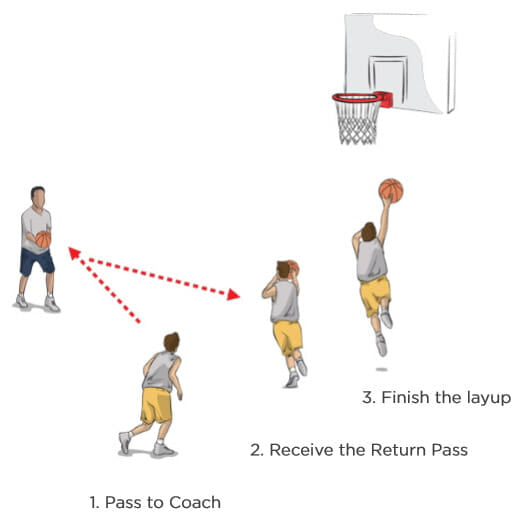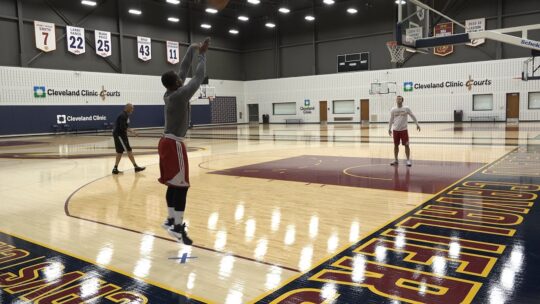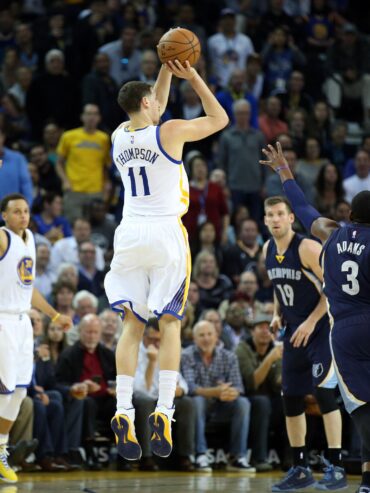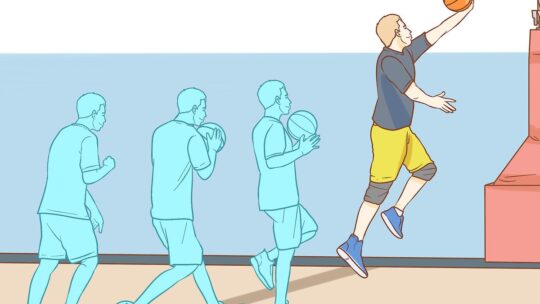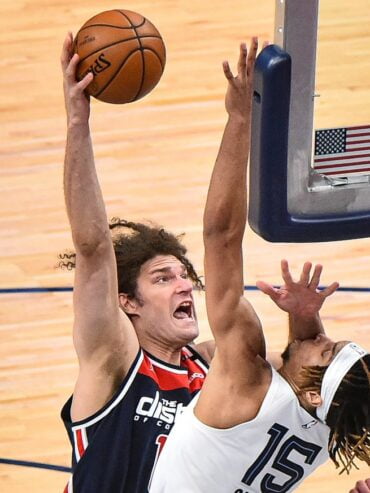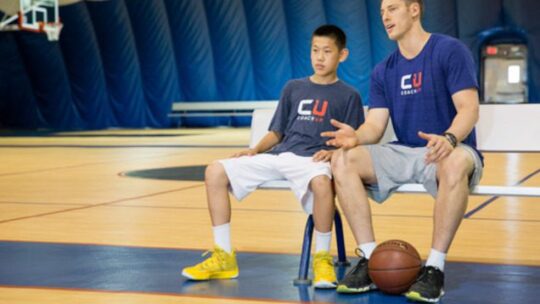Youth Basketball Shooting Drills
What basketball is all about – the shot. To excel at the game of basketball you have to be able to put the ball in the hoop. Either from short range, under the hoop, or from downtown. You aren’t a basketball player if you can’t sink a shot.
In this chapter we are going to take you step-by-step through most of the basketball shooting drills under the sun: The set shot, the jump shot, the layup, the hook shot, post moves, and anything else we can think of.
We will describe briefly the science behind the shooting and the proper technique for every shot, and then at the end, we will give you a couple of drills that you can use to help you become a higher percentage shooter.
The science behind the shot
There are three scientific points about shooting a basketball that no one can dispute. If you know and understand how each works, immediately you will become a better player.
The cylinder
Think about the basketball hoop for a moment. It has an 18” diameter, while a basketball has a diameter of just over 9.5”. That leaves a lot of open space to sink a basket, doesn’t it? Or does it?
It depends. And that’s where understanding the science behind the basketball shot comes in handy. Picture the hoop as a cylinder from floor to ceiling — a long tube that is prepared to suck your basketball in for one, two, or three points.
What is the best way to get the ball into that cylinder with the greatest chance of being sucked in for a basket? If you drop it straight down into the cylinder, of course.
BASKETBALL SHOOTING DRILLS Tips
So what does this mean for your shot, you ask? Well, it’s simple the greater the arc on your shot, the greater chance it has of going in. When you think about it from that perspective, you will probably never pop off a flat brick again in your life.
If you flatten out the trajectory of your shot, you give yourself less and less chance to make it into the hoop.
By increasing the arc of your shot, you are opening up as much of the 18” diameter hoop for your 9.5” ball. If you come in at a lesser angle, physically the hoop is no smaller, but mathematically you are shrinking the opening of the hoop.
- Angles
The second scientific thing to think about is angles. This is important for shots off the glass or simple rebound shots. It is a common sense tip that a lot of players overlook when using the glass for their shot.
When you take a shot, think of it like you would a pool shot. Physics says an object projected at a solid, flat surface will return directly to you. It also says an object sent at an angle to the flat surface will rebound at the same angle.
For example, if you take a 15’ jumper and just kiss the glass at about a 10-degree angle, the ball will leave the glass at, or close to the 10-degree angle. It’s physics – you can’t mess with it. The only time this rule doesn’t apply is if a player puts a considerable amount of spin on the ball, or ‘English’ as it is referred to in billiards.
Angles are a good thing to know about when making layups or shooting from close to the hoop. Understanding them will increase your field goal percentage in the long run.
- Backspin
Most basketball players shoot with some backspin, but sometimes not enough. What they may or may not understand is when you have backspin on the ball when you shoot, when the ball hits the rim (with the appropriate arc), it tends to bounce straight up, rather than off to the side, giving you an extra chance for the ball to drop. Make sure you flick your wrist when shooting – but we’ll get more into that in the technique of shooting.
- The technique
No matter what shot you take, unless it is an unreal, coast-to-coast dream shot, all have the same fundamentals. In one way or another, each of these shooting pointers has an impact on the success of the shot.
- Squaring up to the hoop has got to be the single most important element of shooting, especially for jump shots. If your shoulders aren’t square to the hoop, you don’t even give yourself a chance to be a great shooter. Imagine a line between the front of the hoop and your sternum. If your shoulders aren’t at a right angle to that line, you have a problem. Your shots are likely off-target far more than they are on. Your hips should also be square to the hoop the same way your shoulders are
- Be in control. You can’t execute a proper jump shot or hook shot if you don’t have balance. Watch the best shooters in college and the NBA. They may do things at lightning speed, but they always get control of their body, square up to the hoop, and drain the jumper.
- Pick a target. It doesn’t matter where it is – the back of the rim, the front of the rim, or the backboard. If you zero in on a target, you increase your chance of sinking the basket.
- Bring the ball up through a cylinder (see the pictures below), and rotate it so one hand is on the side of the ball as the guide, and the other hand is behind the ball, ready to propel it at the target. Keep the ball in that cylinder from start to finish to give yourself the consistency you want to become the best shooter. Make sure you release the ball just above head level.
Follow through at the hoop. Flick your wrist to get the backspin on the ball. By following through at your target you almost ensure it will hit the intended target.
Each of the following shots will utilize the same techniques to a certain degree, each with its small differences.
- Set shot
This shot, which came before the jump shot, is used primarily for free throws or open, perimeter shots. It has the fundamentals players use for jump shots, just without the jump.
Make sure your feet, shoulders, and hips are square to the hoop. You can’t make a shot with your hips aimed one way, and your shoulders and feet another. Your knees should be bent slightly because you will use them as the springboard for the force of the shot.
Hold the ball with two hands, but don’t shoot the ball two-handed. You should have your shooting hand directly under the ball (not on the side), and your wrist cocked to flick it on release.
All shots have a set point. This is where the ball is going to be released. Most younger players have a lower set point because they can’t lift the ball too high and still get enough force behind a shot. But, if you are at the high school level, your set point should be at the forehead or higher. This is to prevent blocks by releasing the ball as high as possible and still maintaining accuracy.
Bring the ball up the cylinder as described before, and keep it in that cylinder until you are ready to release the ball. Any deviation from the cylinder will decrease the ball’s chance of hitting the target accurately.
Use the force from the leg thrust to propel the ball to the target. If you try too hard to use your arms and push the ball, your chance of throwing the ball off target increases.
Follow through to your target.
- The Jump Shot
This shot is the bread and butter of the best NBA shooters. I can make this simple: Use the tools from the set shot, but add a jump to it.
The real keys to a successful and accurate jump shot are timing and control. You can’t make a jump shot if your body is totally out of control. I’ve seen players streak from one end of the court to the other and then 15 feet out, with all of their built-up momentum, just take a shot (a brick at that) and it is an easy rebound for the defense.
If you are charging down the court, just before you take a shot (this should be the standard for any jump shot) take a couple of small ‘control’ steps, get your control, and your balance, and then you have a solid platform to make the jump shot.
The jump of your jump shot should be straight up and down and not to the side. You can fade back, but generally speaking, that jump is still straight up and down. You may think you need to avoid a blocking defender, but with the proper overall timing and technique, you should have no problem shooting over the block.
Here is one drill you can use to perfect the above shooting technique:
Stand in one spot about 10 to 12’ from the hoop. The foul line works, but it is best to vary the position you are shooting from and the distance, so try several positions.
Get in the proper shooting position, and prepare the ball as though you are going to shoot. Mentally go through the technique described above, just do it at half-speed. Make sure you slowly and deliberately go through each of the steps to become comfortable with and to teach your mind and your body what the proper form is.
Take 10 to 15 shots from the same position (ideally if you get good at sinking the shots the ball will come back to you) and then vary the position of the shot.
NBA players use this drill when they are in a field goal funk.
The lay up
This should be the easiest shot on the basketball court, but for some strange reason it is the one I see most often missed when it shouldn’t be
The layup is commonly the shot a player uses when they drive to the hoop. But, unfortunately, it is the one shot that employs the greatest variation from player to player. That’s the downfall of this easy basket.
There is a tried and true method to making this shot. If you are willing to use it every time you go to the hoop, I will guarantee you will either sink your shot, draw the foul, or both. It is as simple as that.
Think back to elementary school gym class, and how awkward it was to try and get the steps down to put the ball up to the hoop. It was like walking and chewing gum at the same time.
But, eventually, you mastered it and by the time you hit seventh grade, you could sink a layup 99 times out of 100. So what happened? I’ll tell you what happened… you started watching the NBA.
If you use the same technique your phys ed teacher taught you way back in grade school, you will have the layup.
Here it is, in all its glory. Bounce, bounce, step, step, jump, and in. Easy as pie. So why do you miss it? Are you trying to finger-roll layup? Are you releasing it with your palm up instead of straight ahead? Are you only going up with one hand?
All of those things (and more) lead to inconsistency when driving to the hoop.
Here are a few tips for making the layup 99 times out of 100:
- Use two hands ALL of the time. No questions asked. You are going to get it batted from your palm every time unless you maintain firm control of the ball.
- Don’t be fancy. I admit there will be times you need to maneuver the ball around a hand or two, but trust me when I say you are better off taking it straight to the hoop no questions asked. You will draw far more fouls if you go right for the basket rather than dipsy-doodling around defenders.
- Stride through the lane. You have to go through the lane with conviction to reach the point at the basket where you want to release the ball. If there is a man in the way, or hands are swatting the ball as you drive the lane, you still have to get through.
- Keep your wrist facing forward and release the ball just below the hoop. Don’t get too far underneath the hoop or you aren’t going to have a hope of getting the shot to drop. Place the ball gently against the backboard at the appropriate angle and you have a basket. Keep two hands on the ball until you release it to the hoop.
Again, there is no reason a player at the high school level should miss more than a handful of layups during a season. And the only time you should miss at that is if you have a defender covering you like glue forcing you to alter the shot.
The Hook Shot
This one was probably made most famous by Kareem Abdul-Jabbar of the Lakers. His skyhook became his marquee shot and set the stage for Shaq’s baby hook and others.
The hook shot has its pros and cons. It is a great shot to have in your arsenal, especially if you are a big man. But it goes against most of the conventional techniques I have described in the pages prior.
You won’t be square to your target, you could well be off balance, leaving the accuracy of the shot at a minimum. Unless you spend hours practicing, this shot is a low percentage, even at the NBA level. Typically this is a shot that has to be made inside 10’, simply because of its potential for a miss.
What it does offer the player is a shot that can be made under intense defensive pressure and the ball is protected from any block by the ball-handlers body.
Here are a few tips you can use to make the hook shot a part of your arsenal:
- While you can’t be square to the target, you can do your best to make sure your shoulders are perpendicular to the hoop. The closer you can get to making that angle 90 degrees the greater you increase your chance of draining the hook shot. Picture yourself as one of those old scales that weigh one side and the ball on the other. When you release the ball and your shoulders are perpendicular to the target, you already have a set path for that ball to travel.
- Your shooting arm should be away from the basket, on the other side of the perpendicular shoulders. This is to keep the ball away from the defenders.
- Have your non-shooting arm in front of you, just to act as a counterbalance. This helps the stability of your body and the accuracy of the shot
- Lift your arm, flick your wrist, and propel the ball toward the hoop. It may be easier when you are learning the hook shot to use the backboard to help you hit the shot.
- If you want to become good at this shot, it requires a lot of patience and practice to perfect it.
If you can make the hook shot a part of your basketball repertoire, that’s great, it could pay dividends at State Championships down the road.
Posting up
The world of the big men is staring you down, and you are going to need moves to get you in tight to the hoop so you can either make the easy dump in or jam it home.
This side of basketball shooting has so many variations, a book could probably be written on all of the possible post-up moves a player could make. We’ll try to isolate a few of them for you to put into your arsenal and show you a couple of tips when you develop your post-move.
The drop step
When you are posting up, chances are you are being played pretty tight, and your defender is likely covering the baseline because they have helped through the middle. The drop step, if executed correctly, takes advantage of an aggressive defender.
When you have your hand up waiting for the pass, get in tight to the defender and give him the feeling he can intercept a pass if it comes into you. When you are set, take a jab step out to receive a pass. The defender should be trying to prevent you from getting the pass, but the jab step puts you one step ahead.
Once you get the pass, put the ball to the floor once and hook your baseline foot behind your defender. Pivot and move toward the hoop. You should have boxed the defender out and had a free shot at the hoop. If your defender does try to recover, he or she will likely foul you coming from behind.
It is important with this move to execute it quickly, to take advantage of the defender who has over-pursued the ball. A variation, once the defender gets a hang of the quick hit to the hoop is to throw a fake in there and then draw the foul when he or she is in the air.
Drop step – two
You can do the same move but this time go to the center of the key. Receive the pass without the jab step, make a fake to try the baseline drop step, and hook your foot around the key side and either drive right to the hoop or try a little jump hook if the help-side defense has arrived.
This move is especially effective against a man-to-man defense because it is less likely you will get caught up in help defense.
Step-and-a-half
For the step-and-a-half, you need to receive the pass and front the defender. Fake the short jumper to get the defender moving in the air – this is where they are most vulnerable.
Once the defender is in the air they are easily beaten. You needn’t even put the ball to the floor to execute this move, just step one step around the defender while they are in the air, and with that step take off at the basket.
You will not be called for traveling as long as you lift off with the foot you took the step with. That’s why it’s called the step-and-a-half. You are taking one step and almost taking another in the air.
Back door lob
This one is especially effective with a guard who can put the ball on the money. Take your defender to the top of the key, near the free-throw line. Make sure you have the inside position, to the center of the paint.
Signal your guard make a drop step toward the hoop and seal your defender from the hoop – almost like boxing them out. The guard lobs the ball to you on your way to an easy basket.
Making a living in the paint
There’s no doubt there is a wide range of different moves a post player can use but still, there are fundamentals a player can keep in mind to make the post move they use more successful.
- Use your body to your advantage. Most of the guys who are going to be on the post player are of the wide body variety. Make sure you shield the defender from the ball and take advantage of size disparities when you have the chance.
- This sounds simple but keep the ball away from your opponent. Shield the ball – keep elbows, arms, and upper body in the way of the ball. You don’t want it swatted from you when you go to make a move.
- Don’t be afraid to use your dribble. Too often big men are expected to receive a pass and make one quick move and then to the hoop. Use your dribble to get you into the best position to make a move. Many post moves require you to get position before you can make a move, and even more, are executed after you pick your dribble up.
- Keep your head up. People will be cutting under the hoop waiting for a pass from a big man who has been stymied at the baseline. Don’t be afraid to use the dish if there is nothing under the hoop.
- Keep your head up again. You need to know where the ball is at all times to make sure you can take advantage of a sleepy defender. Many of the moves you make will come off of quick passes and quick moves like the drop step.
- Go to the hoop. Especially at the younger age level, I don’t see enough kids take the ball to the hoop. Yeah, you’re probably going to pay a little bit of a physical price, but 9 times out of 10 you are going to get fouled. Take the ball to the hoop. As a post-guy, you need to be able to take the ball to the hoop to be effective.
The majority of points in higher level basketball are scored from inside 10”. The majority of those are scored from right underneath the hoop. Most players have one of the most important jobs on the offensive court.
Other shots you can learn:
- Finger roll – The finger roll is a shot many players use instead of a layup. It requires a bit more finesse to make sure the ball hits the mesh, but it can be effective if you use it from a couple of feet out with a flick of the wrist. When you go in for a lay you can just flick your wrist in front of a defender and it goes up and over the block.
- The Dunk – Hey if you can do it, there is no better post-move out there. Drop step and jam – you’ve seen Shaq or David Robinson do it a thousand times – and you’ll see the big guys do it a thousand more.
Foul Shots
Everybody’s nemesis at one point or another, this shot is probably the easiest to practice because it should be the same motion every single time you set up to take a free throw. With practice, every player should be able to hit at least 75 percent of their free throws. In my opinion, there is no reason Shaq only shoots 50 percent. The free throw is easy – I have seen an 85-year-old man sink about 70 in a row. You can do it too!
Learning the free throw:
The first thing you should do is – do the same thing every time. No matter what, and no matter what point in the game it is, and no matter how tired you are – do the same thing every time. Have a routine for making free throws. If you do everything the same each time you get to the foul line there should be no problem with you making each free throw.
If you need to shake the rocks out of your shoes or need to bounce the ball 12 times and then spin it in your hands before you shoot, then do it. But do it every time you get to the foul line. When you establish a rhythm that is comfortable for you, you will begin to sink the foul shot on a more regular basis.
With that said, there are a few tips I can offer to make you a better free throw shooter.
- I know there are people out there who will tell you it’s OK to put one foot in front of the other to shoot free throws because it is more comfortable. I say they are wrong. You need to be square to your target. Square with your shoulders, square with your hips, and square with your feet.
- Set up at the free throw line with your shooting hand lined up directly with the hoop. This may seem awkward at first, but it is easier to shoot the ball in one fluid motion (set shot) than it is to try and bring the ball to the front of your body before you release it.
- Take a deep breath and watch the ball go in. Relax and take a nice easy set shot. There is no pressure. It is just a simple set shot
- I will say this again. Make sure you do the same thing every time you are at the free-throw line. It will make you more comfortable when you are ready to take a shot. Familiarity takes a lot of the pressure off of a big shot.
Free throws will account for a large part of a score sheet when all is said and done. The team that has the highest free throw percentage and has gone to the free throw line the most is often the winner of the game.

